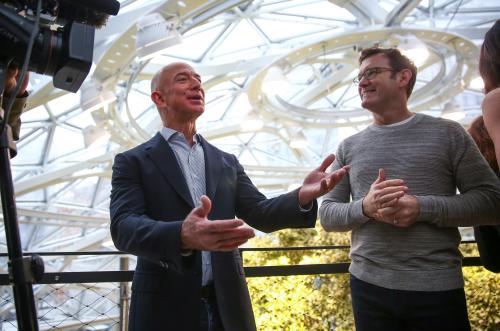Though the cat’s been out of the bag for more than a week now, Amazon’s announcement this morning that the company will split its next “headquarters” between the New York City and Washington, D.C. regions sends a clear signal about what matters most to regions seeking to build a high-tech economy: talent.
Sure, the Long Island City and National Landing (née Crystal City) sites have a lot of other things going for them, too. They have buildings that Amazon can occupy quickly. They have excellent transit access. They are proximate to airports from which Amazon employees can access markets all over the country, and travel back and forth to HQ1 in Seattle (Amazon employees in Northern Virginia will literally be able to walk to Reagan National Airport). They’re in the Eastern Time Zone, arguably improving Amazon’s ability to work in the European market. And yes, Jeff Bezos owns homes near each site, as Scott Galloway notably observed.
But other than Bezos property, other finalists had several of these ingredients, too. Where they couldn’t match New York and D.C. was the deep tech talent pool.
Looking at all U.S. metropolitan areas by the number of people working in computer and mathematical occupations—a decent proxy for the nation’s tech workforce—shows that the New York and Washington, D.C. regions far outpace all others. Greater New York had 321,000 such workers in 2017, while Greater Washington had 264,000. The metro area with the next largest tech workforce, Los Angeles, lagged well behind at 173,000. To be sure, the San Francisco Bay Area is a mecca for tech talent, too, split between two metro areas (San Francisco and San Jose), but even together they only slightly outpace the D.C. region at 287,000 tech workers.

The critical importance of readily available talent to Amazon is evidenced by the company’s decision to split the next headquarters between two sites. Indeed, the answer to the first “frequently asked question” from Amazon’s press release states, “We can recruit more top talent by being in two locations.” Amazon may also perceive less risk in sourcing existing tech talent from within an expansion market, versus turning that market into a magnet for tech migrants, and placing even greater pressure on local housing prices.
The critical importance of readily available talent to Amazon is evidenced by the company’s decision to split the next headquarters between two sites.
That New York and D.C. have such considerable numbers of tech workers reflects complementary advantages in their efforts to attract Amazon. In New York, many of those workers are actually in the finance industry, and in D.C., many work in government. Both sectors represent key clients for Amazon’s services, so anchoring its expansion in these markets gives Amazon improved access to its customer base.
All this suggests takeaways for both the losers and the winners in the HQ2 contest.
Cities that didn’t win should take up the challenge of growing a digitally-oriented workforce at scale through significant investments in training, and complementary strategies to grow technically advanced jobs from within their current employer base. These and other cities should examine and re-tool their economic development incentives to prioritize investments in workforce preparedness.
And for the winners: Did you have to pay Amazon all that money in the end? I’m especially looking at you, New York state. If nothing else, Amazon’s decision reinforces that we’re overdue for a national solution to the problem of corporate giveaways.






Commentary
For Amazon, HQ2 location decision was about talent, talent, talent
November 13, 2018